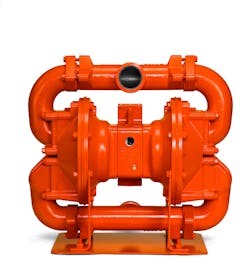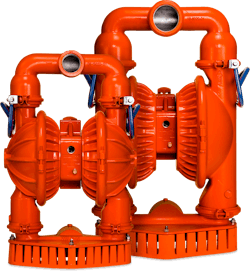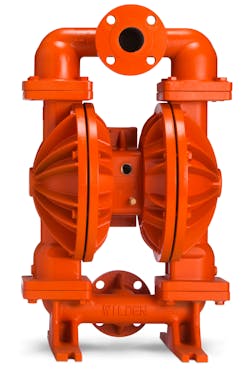How AODD pumps can satisfy all demands in mining operations
Mining is one of the world’s oldest industries, tracing its roots back to those prehistoric days when someone grabbed a digging instrument and began burrowing into the ground. In the many millennia since then, mining has grown into one of the world’s most important and widespread commercial enterprises, with mining operations spread across the globe while tasked with recovering an almost inexhaustible list of valuable commodities.
In fact, according to the World Mining Congress’s World Mining Data 2020 report, 17.7 billion metric tons of mined products were recovered in 2018, up from 11.3 billion metric tons in 2000 and nearly double the 9.6 billion metric tons in 1985. Asian countries accounted for 58% of the 2018 production, with North America second at 15.1%, followed by Europe (8%), Oceania (6.8%), Latin America (6.3%) and Africa (5.3%). Individually, China (23%), the United States (12.1%), Russia (9.2%) and Australia (7.2%) were the most prolific producers, with their total 51.1% of production more than the rest of the world combined.
This means that the mining industry is a strong one, with solid growth expected to continue in the coming years in many regions of the world. It also means that mining operations will continue to rely on pumping technologies that offer robust, reliable and safe service in a number of critical liquid-handling operations. This article will illustrate why positive displacement air-operated double-diaphragm (AODD) pumps can be the best choice for many of those applications.
The challenge
While mining might appear to be nothing more than a rough-and-tumble operation — holes are dug by heavy machinery or with explosives, opening the hidden ode to access from above — there are, in fact, many complex and sometimes delicate operations that must be performed properly if the mining operation is to perform at its highest level of efficiency.
From a macro standpoint, this requires a pumping technology that can operate reliably in harsh and remote locations, even when submerged, or when tasked with handling particulate-laden liquids or toxic/corrosive products, and also one that is able to be maintained and repaired simply so downtime is lessened. The pumps must also be light enough to be manually moved from location to location within the mine itself.
For many years, a popular choice for use in these conditions was centrifugal pumps. While centrifugal pumps are able to create the high flow rates that are required, they have a number of operational “pain points” that hamper their use in mining applications: an inability to self-prime or run dry; special seals needed to prevent leaks; special linings needed to handle solids; high motor speeds of up to 1,800 rpm; and relatively high maintenance requirements and costs, especially when charged with transferring solid-heavy liquids.
Another popular choice has been the progressive cavity pump, but, like centrifugal pumps, they have a number of operational shortcomings. These include an inability to consistently handle liquids with high levels of abrasives, which leads to increased maintenance costs, wear on expensive stators and rotors that will eventually need to be replaced and overall higher purchase, operating and repair/replacement costs.
Here are some of the specific liquid-transfer operations that take place in a mine and the ways that some pump technologies can fall short in satisfying them:
- Mine dewatering: Removing excess produced water from the mine is a critical 24/7/365 operation and the water that is recovered is often full of particulates that can be as large as 3-4 mm (0.12-0.16") in size. If used in this application, centrifugal pumps require special materials of construction, which can be cost prohibitive, to protect against impeller wear caused by the abrasive particles. Centrifugal pumps are also not dry-run capable, which adversely affects their level of performance in this application.
- General service: For common liquid-handling applications, you need an easy-to-operate pump that reliably can run dry, strip lines, operate at low speeds while still delivering high flow rates, and be easy to maintain and repair. Centrifugal pumps simply do not possess these capabilities.
- Corrosive liquids: Much like solid-laden liquids, corrosive ones can wreak havoc on the wetted parts of centrifugal and progressive cavity pumps. This typically demands a need to use special mechanical seals, which can lead to exorbitant maintenance, repair and replacement costs.
- Press filter: Press filters are used to clean the liquids that are produced in the mines and, again, centrifugal pumps can fall short in this application because the solid-laden liquid can damage the pump’s internals unless special, more expensive materials of construction or linings are used. Also, the nature of press-filter operation creates a strong discharge-pressure variation that can force the centrifugal pump to operate away from its best efficiency point (BEP), resulting in high vibration and radial loads that can lead to shortened service life. A solution to this is the incorporation of variable frequency drives (VFDs) and controllers, but these are expensive and can negatively affect the cost-effectiveness of the operation.
- Product transfer: This comes in all forms in a mining operation, from loading and unloading from transport trucks with new and used oil for the heavy machinery, fresh and fouled water, and any chemicals that are required. In every instance, there is the risk that the pump will be forced to run dry as the truck or storage vessel is emptied, while discharge-pressure variation can also generate high vibration and radial loads. As previously illustrated, centrifugal pumps cannot run dry, so they need protection from this condition or the addition of special seals. However, all of these upgrades still cannot totally protect against a catastrophic failure.
The solution
While centrifugal pumps — despite their popularity — have proven to not be the most effective solution in many liquid-handling applications in mining, one pump technology that has proven to be an optimum choice is AODD — in terms of maximizing reliability, cost-effectiveness, ease of operation and maintenance, and safety for mining personnel and the environment.
AODD pumps are able to perform effectively in mining applications because their method of operation allows them to easily handle variable flow rates and pressures, while being dry-run and line-stripping capable, and nimble enough to transfer liquids that are shear-sensitive or high-viscosity, as well as slurries laden with rocks, pebbles and other particulates.
The simple design of the AODD pump features few moving parts and comparably lower speeds than other pump technologies, which improves reliability and simplifies maintenance, while the pump’s seal-less construction results in fewer leaks, which is a critical consideration when handling the many hard-to-seal, corrosive or hazardous liquids that are prevalent in a mining operation. AODD pumps are available in both metal (most commonly aluminum, ductile iron and cast iron) and plastic (polypropylene and PVDF) housing constructions, while a wide array of elastomers can be used in the diaphragms, which eliminates many chemical-compatibility concerns.
A wide variety of AODD pump configurations provide operational flexibility that can also result in optimized performance at many levels. The ability to feature AODD pumps in a wide range of applications, from basic general use to delicate chemical-handling processes, allows operators to more cost-effectively outfit their mines. AODD pumps can also be less costly to operate, especially those models that are outfitted with a next-generation mechanically actuated air distribution system (ADS). At their most basic, AODD pumps excel in the typical rugged and harsh operating conditions found in the world’s mines, which reduces breakdown incidents along with corresponding downtime and repair costs.
Wilden, whose founder, Jim Wilden, conceived the AODD pumping principle 65 years ago, has been dedicated to developing technologies that meet the needs of mining operations. Today, Wilden offers three AODD pump models that are built to excel in mining applications: Brahma Series AODD Pumps, Stallion Series AODD Pumps and the Pro-Flo SHIFT Series. All of the Brahma, Stallion and Pro-Flo SHIFT pumps are able to be outfitted with a wide array of diaphragm styles. This diaphragm range gives users the widest selection of diaphragms on the market, all of which are capable of providing extended mean time between failure (MTBF) for optimized uptime with reduced maintenance, repair and replacement costs.
All of these capabilities make AODD pumps the ideal choice for the aforementioned common liquid-handling applications in mining: dewatering, general service, corrosive-handling, filter press and daily product transfer.
Conclusion
In summary, AODD pumps are the best option for mining applications because they offer considerable operational advantages, like comparable low-speed operation, dry-run, line-stripping, self-priming and deadhead capability, along with increased operational safety and a reduction in maintenance/repair costs that can be incurred by pumps that are not designed to handle abrasive/corrosive or solid-laden liquids.
Fernando Meneses is the regional manager for north Latin America for Wilden, a leading manufacturer of air-operated double-diaphragm (AODD) pumps. He can be reached at +51 127 37402 or [email protected]. Wilden is a product brand of PSG, a Dover company.


